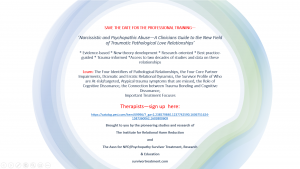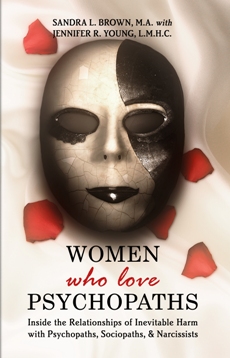Pathology is a mental health issue, not a gender issue. Women have just as much pathology in some areas of personality disorders, as men do in other areas of personality disorders. Some of the 10 personality disorders present more in men, while some of the disorders present more in women.
As you have heard me say over the years, pathology is pathology – meaning that each personality disorder has it’s own problems and challenges in relationships, but mainly holds to the central three aspects that I talk about related to pathology:
1. The inability to grow to any true emotional or spiritual depth.
2. The inability to consistently sustain positive change.
3. The inability to have insight about how one’s behavior negatively
affects others.
Given those three aspects of personality disorders, we can easily see how each of the different types of personality disorders can be linked together by these three ‘inabilities.’
While men may be more bent towards Anti-Social Personality Disorder or psychopathy, women may show more of a bent towards Histrionic, Dependent, or Borderline Personality Disorder. When you have a man with a personality disorder coupled with a personality disordered women – it equals Jerry Springer Dynamics!
There is no guarantee that there is only one pathological in the relationship. Women have just as much mental illness, addictions, and personality disorders as men. It’s quite common for people with a personality disorder to hook up with another disordered individual. When this happens you have two people who can’t grow to any true depth emotionally or spiritually, two people who can’t sustain positive change, and two people who don’t have insight about how their behavior affects others. These relationships are dramatic fire-beds of emotionality, addiction, and violence.
Women’s pathology is just as damaging to men as men’s pathology is to women. Women’s pathology may present differently than men’s overt aggression related to their pathology, but it is not any less problematic. Women’s pathology can sometimes (and I use the word ‘sometimes’ lightly) be subtle when it is masked behind emotional dependency, sexual addiction, sexual manipulation, financial dependency, or high emotionality. Those types of symptoms can be associated with more than just a personality disorder. But women’s pathology is just as damaging to a partner, a boss, their family, friends, and God forbid, the effects it has on their children.
While women are more likely to be diagnosed as Borderline Personality Disorder, borderlines are often misdiagnosed, and under-diagnosed psychopaths and anti-socials. There seems to be somewhat of a gender-bias when it comes to diagnosing women with psychopathy. Unless they have participated in a Bonnie and Clyde-type episode, or made the America’s Most Wanted television program, they are likely to be downgraded in their pathology. Dramatic, highly emotional, or self-injuring women may be downgraded to Histrionic, Narcissistic, or Borderline Personality Disorder. Those with a little more flare for hiding their real lives may warrant the same diagnosis as male psychopaths. Their ability to hide it better, or having less violence associated with their behavior, goes undiagnosed, or misdiagnosed. But not all female psychopaths are non-violent. Many are horribly violent – to their children and their partners – yet always present themselves as the victims. These are the women most likely to press unwarranted domestic violence assaults, cry rape that didn’t happen, and abandon their children. The point is, both genders can have personality disorders and each personality disorder may, or may not, present in a slightly different way in the other gender.
Beyond mutual pathology, a woman’s own mental health can influence the dynamics within a relationship with a pathological man. A woman that has bipolar disorder that is untreated, and who is in a relationship with a borderline male, can bring unusually dramatic dynamics to the relationship. Their fluctuations in mood can ignite a feeding frenzy of boiling anger in both which is likely to lead to violence. Both partners having a substance abuse or alcohol problem can certainly fuel the relationship dynamics in further, severely negative ways.
Let’s not overlook the ‘model’ of pathological behavior that women often get from being raised in a home with a pathological parent. She brings to the relationship the pathological-like behaviors that are learned within pathological families. I have seen this in sessions with women (and hear it a lot in the emails I receive) where the pathological affects of her childhood, adult life, or past or current relationship is negatively affecting her worldview, current level of functioning, as well as the entitlement attitudes she brings to the table. Couple any of HER mental health issues and situations along with HIS pathology, and you have some of the most volatile and difficult relationships and breakups in history.
There has been many times in working with women that I recognize he is not the only problem in the scenario. Not all women in pathological relationships are mentally ill. However, some women in pathological relationships ARE mentally ill. Some of her own mental illness can be the gasoline on the fire of the pathological love relationship that fans the flames of danger for her. Red flags, for me, that show there is possible mental health issues with her includes the following:
• Entitlement
• Chronic victim mentality
• Unregulated mood issues not amenable to treatment/medication
• Chronically returning to the pathological relationship
• Replacing relationships with more pathological relationships
• History of unsuccessful counseling/treatment
• Doesn’t take responsibility for her own behaviors/choices
These represent only a few of the many symptoms that could indicate a possible mental health issue in the woman as well. Clearly, pathology is not gender specific. Pathology and other mental health issues in both parties can accelerate the dangerousness and problems seen in pathological love relationships.






